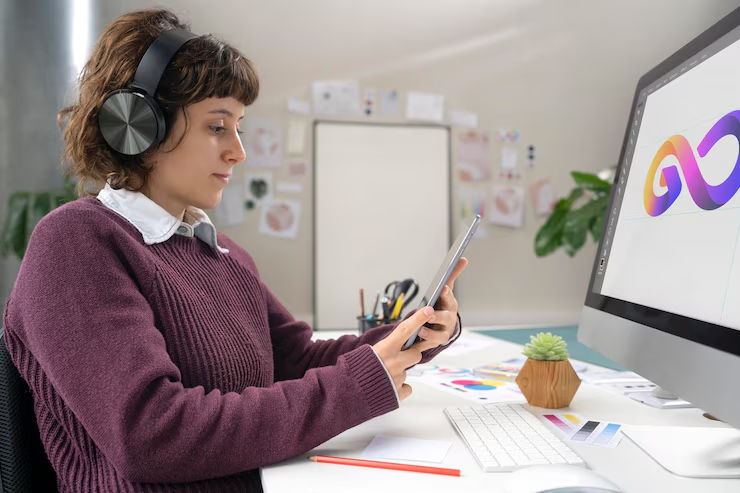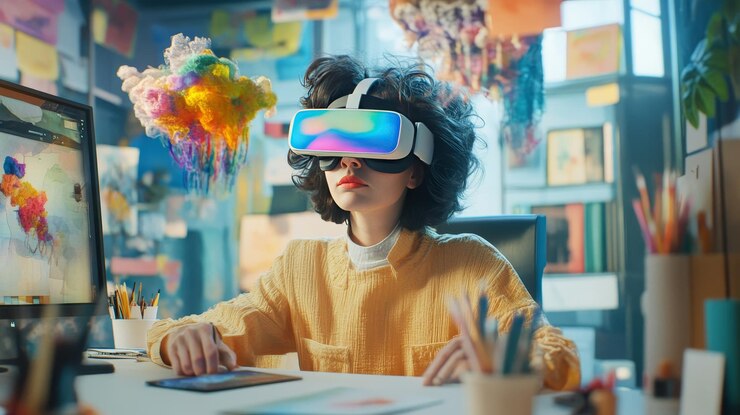Digital Design is changing the way we see and interact with the world. From websites to apps, digital design is everywhere around us, shaping our daily experiences. Whether you’re scrolling through your phone or browsing a website, you’re engaging with digital designs created to make your experience smooth and enjoyable.
In today’s world, digital design is more than just making things look pretty. It’s about creating designs that are functional, easy to use, and engaging. Digital designers work hard to ensure that every click or tap feels intuitive. This blog post will dive into the world of digital design and explore how it’s shaping the future of creativity.
What is Digital Design? Understanding Its Role in Modern Life
Digital design refers to the process of creating visual content using digital tools and technology. From websites to mobile apps, digital design is behind everything you see online. It includes graphics, layouts, color schemes, and even how websites function when you click or tap on them.
In simple terms, digital design is what makes the online world look appealing and easy to use. Every time you visit a website or use an app, digital designers have worked to make sure it looks good and works well. It’s not just about making things pretty; it’s about making them practical and user-friendly too.
The role of digital design is growing every year as more businesses, organizations, and people use digital platforms to communicate. Whether you’re shopping online or reading an article, digital design is shaping your experience and guiding you through the process.
Why Digital Design Matters: Its Impact on User Experience
Digital design plays a huge role in how we experience websites and apps. Good design can make using a website feel like a breeze, while bad design can leave you frustrated and confused. The key is to make things easy for users by keeping designs clear and simple.
- Easy navigation: A website with good digital design will have easy navigation, so users can find what they need quickly.
- Attractive layout: Well-designed layouts help visitors stay engaged, making them want to stay longer on the site.
- Responsive design: Good design adapts to different devices, like phones, tablets, and computers, offering a seamless experience everywhere.
The impact on user experience is big because when things are easy to use, users are more likely to stay and return to a website or app. Poor design, on the other hand, can lead to people leaving before they even get a chance to explore the content.
How Digital Design is Shaping the Future of Websites and Apps
As technology continues to evolve, digital design is shaping the future of websites and apps. Designers are now focusing on creating experiences that go beyond just looking good. It’s about making things work in a way that feels natural and easy.
One key change is mobile-first design, where websites and apps are designed with mobile devices in mind first. This is because more people now use smartphones and tablets to browse the internet than desktop computers.
- Faster load times: A well-designed website will load quickly, making the experience better for users.
- Interactive features: Modern digital design often includes interactive elements, like animations or scroll effects, making websites more engaging.
- Minimalist design: Less is more, and digital designers are embracing simpler, cleaner layouts that focus on what matters most.
These trends are shaping the way websites and apps will look in the future, focusing on creating smoother, faster, and more enjoyable experiences.
The Key Principles of Digital Design Every Designer Should Know

When it comes to digital design, there are a few important principles that every designer should follow to create great work. These principles help make sure the designs are both beautiful and functional.
Simplicity is Key
- Keep it simple: Simple designs are easier to understand and navigate.
- Avoid clutter: Too many elements can make a website feel chaotic, so it’s better to focus on what’s most important.
Consistency Across Pages
- Color scheme: Use the same colors throughout a website to create a unified look.
- Fonts: Stick to just a few fonts to keep the design clean and readable.
By following these basic principles, digital designers can create websites and apps that are not only beautiful but also work well for the users.
How to Get Started in Digital Design: A Beginner’s Guide
Starting your journey in digital design might seem like a big task, but it’s easier than it looks. Here’s a simple guide to help you get going.
Learn the Basics
Before jumping into complex tools, start by learning the basics of design. Understanding concepts like color theory, typography, and layout will give you a solid foundation.
Get the Right Tools
To design digitally, you’ll need the right tools. Programs like Adobe Photoshop, Illustrator, and Figma are some of the most popular tools that designers use.
- Photoshop: Great for image editing.
- Illustrator: Ideal for creating vector graphics.
- Figma: Perfect for collaborative design work.
Practice, Practice, Practice
The best way to get better at digital design is by practicing. Start with small projects, like creating a logo or designing a simple webpage, and keep building your skills over time.
By following these steps, anyone can get started in digital design and work their way toward creating amazing projects.
Digital Design vs Traditional Design: What’s the Difference?
When you think of design, you might imagine traditional methods like drawing on paper or creating designs with physical tools. But digital design has changed the game. While traditional design focuses on using physical materials, digital design is all about using software and technology.
Advantages of Digital Design
- Flexibility: Digital tools allow for easy edits and adjustments without starting over.
- Speed: Designers can work faster with digital tools, making it easier to try new ideas.
- Collaboration: With digital design, it’s easier to share work and get feedback from others.
In contrast, traditional design often requires more time and physical materials, making it less efficient for many tasks. Digital design, on the other hand, is more adaptable and versatile, making it ideal for today’s fast-paced world.
Why Digital Design is Crucial for Business Success
Digital design is not just about making websites and apps look good; it’s a powerful tool that can help businesses grow. A well-designed website can increase trust with customers and create a better overall brand experience. In today’s competitive market, businesses need digital design to stand out and stay relevant.
- Brand identity: Digital design helps build a strong, consistent brand identity across all online platforms.
- Customer trust: A professionally designed website or app can make customers feel more comfortable and confident in your business.
- Conversions: Good design can help guide visitors through a website or app, leading to higher conversion rates, like more sales or sign-ups.
A business that invests in digital design is investing in a better customer experience, which can directly lead to greater success.
The Art of Simplicity in Digital Design: Less is More

One of the most important lessons in digital design is that sometimes, less is more. A simple design can be just as powerful—if not more—than something complex. By focusing on the essentials and removing unnecessary elements, you can create clean, easy-to-navigate websites and apps that users love to interact with.
Key Aspects of Simple Digital Design
- Clean layouts: Keep pages uncluttered by focusing on important content.
- Minimal colors: Use a few colors that work well together to maintain a simple yet stylish design.
- White space: Don’t be afraid of empty spaces. White space helps to create a balanced and easy-to-read design.
When digital design is simple, it’s easier for users to find what they need quickly. Simplicity also makes it easier for businesses to communicate their messages without distractions.
Conclusion
Digital design plays a big role in how we use the internet today. It’s not just about making things look pretty—it’s about creating websites and apps that are easy to use and help businesses connect with their customers. As technology continues to grow, digital design will keep changing, making our online experiences smoother and more enjoyable.
If you’re thinking about starting a career in digital design or just want to learn more, there are so many exciting possibilities. From creating user-friendly websites to designing interactive mobile apps, digital design is a skill that can help you make a real impact in the digital world. Keep learning, keep practicing, and soon you’ll be able to create designs that people love to use.
FAQs
Q: What is digital design?
A: Digital design is the process of creating graphics, websites, and apps using digital tools. It includes everything you see online, like logos, buttons, and page layouts.
Q: Why is digital design important?
A: Digital design makes websites and apps easy to use and fun to look at. It helps businesses connect with customers and keeps users engaged.
Q: What skills do I need to become a digital designer?
A: You need to learn basic design principles, such as color theory and layout, and get familiar with digital design tools like Photoshop or Figma.
Q: Can I learn digital design on my own?
A: Yes! There are lots of free online resources, tutorials, and courses that can help you learn digital design at your own pace.
Q: How do digital designers make money?
A: Digital designers can make money by working for companies, freelancing, or creating their own design projects for clients.
